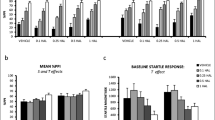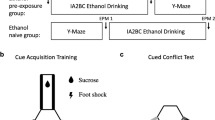Abstract
The Maudsley Reactive (MR/Har) and Non-Reactive (MNRA/Har) rat strains, bred originally by Broadhurst for differences in Open Field Defecation, also differ in their control (i.e., non-drug) behavior in the Conditioned Suppression of Drinking (CSD) conflict procedure, a second “model” behavior for the study of anxiety and/or emotionality in rats. The present studies compared the effects of diazepam and alprazolam on CSD behavior in these two strains of rats. In daily 10-min sessions, water-deprived rats were trained to drink from a tube that was occasionally electrified (0.2–0.5 mA), electrification being signaled by a tone. Both diazepam and alprazolam increased punished responding in a dose-related manner. The per cent increase in punished responding (for diazepam only) was comparable in the two strains; however, both statistical and empirical approaches indicated that the magnitude of the anti-conflict effect of benzodiazepines in MNRA/Har versus MR/Har rats was not related to differences in baseline (i.e., non-drug) punished responding. Based on the absolute change in shocks received, rats of the MNRA/Har strain exhibited a significantly greater anti-conflict effect following diazepam or alprazolam treatment than did rats of the MR/Har strain. These findings further the hypothesis that the behavioral differences exhibited by Maudsley MR/Har and MNRA/Har rat strains may constitute a genetically-based “animal model” for the study of emotionality and/or anxiety.
Similar content being viewed by others
References
Blizard DA (1981) The Maudsley reactive and nonreactive strains: A North American perspective. Behav Genet 11:469–489
Blizard DA, Liang B (1979) Plasma catecholamines under basal and stressful conditions in rat strains selectively bred for differences in response to stress. In: Usdin E, Kopin IJ, Barchas J (eds) Catecholamines: basic and clinical frontiers. Pergamon Press, New York
Blizard DA, Altman HJ, Freedman LS (1982) The peripheral sympathetic nervous system in rat strains bred selectively for differences in response to stress. Behav Neural Biol 34:319–325
Broadhurst PL (1960) Experiments in psychogenetics. In: Eysenck HJ (ed) Experiments in personality, psychogenetics and psychopharmacology. Routledge and Kegan Paul, London
Broadhurst PL (1962) A note on further progress in a psychogenetic experiment. Psychol Rep 1065–1066
Broadhurst PL (1975) The Maudsley reactive and nonreactive strains of rats: A survey. Behav Genet 5:299–319
Commissaris RL, Harrington GH, Ortiz AM, Altman HJ (1986) Maudsley reactive and non-reactive rats strains: Differential performance in a conflict task. Physiol Behav 38:291–294
Commissaris RL, Vasas RJ, McCloskey TC (1988) Convulsant versus typical barbiturates: effects on conflict behavior in the rat. Pharmacol Biochem Behav 29:631–634
Commissaris RL, McCloskey TC, Harrington GM, Altman HJ (1989) MR/Har and MNRA/Har Maudsley rat strains: Differential response to chlordiazepoxide in a conflict task. Pharmacol Biochem Behav 32:801–805
Eysenck HJ, Broadhurst PL (1964) Experiments with animals: Introduction. In: Eysenck HJ (ed) Experiments in motivation. Pergamon Press, New York
Ford RD, Rech RH, Commissaris RL, Mayer L (1979) Effects of acute and chronic interactions of diazepam andd-amphetamine on punished and unpunished behavior of rats. Psychopharmacology 65:197–204
Geller I (1964) Relative potencies of benzodiazepines as measured by their effects on conflict behavior. Arch Int Pharmacodyn Ther 149:243–247
Geller I, Seifter J (1960) The effects of meprobamate, barbiturates,d-amphetamine and promazine on experimentally induced conflict in the rat. Psychopharmacology 1:482–492
Geller I, Kulak JT, Seifter J (1962) Attenuation of chlordiazepoxide and chlorpromazine on a punished discrimination. Psychopharmacology 3:374–385
Harrington GM (1981) The Har strains of rats: origin and characteristics. Behav Genet 11:445–468
Harrington GH, Blizard DA (1983) Open-field behavior in the Maudsley reactive and nonreactive strains: procedural variations. Behav Genet 13:91–94
Kilts CD, Commissaris RL, Rech RH (1981) Comparison of anti-conflict drug effects in three experimental models of anxiety. Psychopharmacology 74:290–296
Liang B, Blizard DA (1978) Central and peripheral norepinephrine concentrations in rat strains selectively bred for differences in response to stress. Pharmacol Biochem Behav 8:75–80
Marangos PJ, Insel TR, Montgomery P, Tamborska E (1987) Brain adenosine receptors in Maudsley Reactive and Non-Reactive rats. Brain Res 421:69–74
McCloskey TC, Paul BK, Commissaris RL (1987) Buspirone effects in an animal conflict procedure: Comparison with diazepam and phenobarbital. Pharmacol Biochem Behav 27:171–175
McCloskey TC, Damian GM, Brown BD, Barraco RA, Altman HJ, Commissaris RL (1988) Antagonism of the anti-conflict effects of phenobarbital, but not diazepam, by the A-1 adenosine agonistl-PIA. Neurosci Abstr 14:1261
Robertson HA, Martin IL, Candy JM (1978) Differences in benzodiazepine receptor binding in Maudsely Reactive and Maudsley Non-Reactive rats. Eur J Pharmacol 50:455–457
Slater J, Blizard DA, Pohorecky LA (1977) Central and peripheral norepinephrine metabolism in rat strains selectively bred for differences in response to stress. Pharmacol Biochem Behav 6:511–520
Steele RGD, Torrie JH (1985) Principles and procedures of statistics. McGraw-Hill, New York
Sudak HS, Maas JW (1964) Neurochemical correlations in Reactive and Non-Reactive strains of rats. Science 46:418–420
Tamborska E, Insel T, Marangos P (1986) ‘Peripheral’ and ‘central’ type benzodiazepine receptors in Maudsley rats. Eur J Pharmacol 126:281–287
Vogel JR, Beer B, Clody DE (1971) A simple and reliable conflict procedure for testing antianxiety agents. Psychopharmacologia 21:1–7
Author information
Authors and Affiliations
Rights and permissions
About this article
Cite this article
Commissaris, R.L., Harrington, G.M. & Altman, H.J. Benzodiazepine anti-conflict effects in maudsley reactive (MR/Har) and non-reactive (MNRA/Har) rats. Psychopharmacology 100, 287–292 (1990). https://doi.org/10.1007/BF02244595
Received:
Revised:
Issue Date:
DOI: https://doi.org/10.1007/BF02244595




